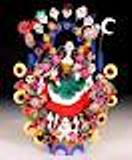DIAS DE LOS MUERTOS
 Thank you, Jewell Gregory, for setting up the Day of the Dead altar in the IPS Lounge!
Thank you, Jewell Gregory, for setting up the Day of the Dead altar in the IPS Lounge!
Day of the Dead is a Mexican holiday. The holiday focuses on gatherings of family and friends to pray for and remember friends and family members who have died. It is particularly celebrated in Mexico, where it attains the quality of a National Holiday. The celebration takes place on November 1st and 2nd, in connection with the Catholic holidays of All Saints’ Day (November 1) and All Souls’ Day (November 2). Traditions connected with the holiday include building private altars honoring the deceased using sugar skulls, marigolds, and the favorite foods and beverages of the departed and visiting graves with these as gifts.
Jewell explains the several typical characteristics of such an altar:
“ One is that it is generally designed to be on more than one level and that is why we added the rectangular box to the table we used for the altar. The dead appreciate sweet smells, and that is why the bar of Sandlewood scented soap is included. In Mexico, there would probably be fragrant marigolds strewn on the surface, which we represent with the flowers. In Mexico Copal incense might be burned to perfume the air, but lacking that, I used a Native North-American sage smudge of the type used to purify the home instead. In order to avoid setting off the smoke alarm, it was burned very briefly while blessings were said for the altar, for those who respect it, and for the spiritual enrichment to be found in observing the Day of the Dead.
An essential requirement, which is undoubtedly one of the pre-Christian aspects of the altar, is that it contains elements relating to wind, fire, earth and water.
There is a folk art form of delicately cut paper that represents the wind. We have some of these little metallic cut-paper banners near the top of the altar.
Fire is represented by the candles, both the votive candles and the two Our Lady of Guadalupe candles.
Earth is represented by the Day of the Dead bread. There are three different types; one represents a human body, and looks something like a big doll. One represents a baby, placed beside the larger figure. The third is a circular loaf decorated with abstract forms representing human bones. Of course the dead can’t eat the bread, but the fragrance of food nourishes them.
There is a bottle of water in fulfillment of that requirement.
In addition, we have some Milagros or ex votos made of metal representing flaming hearts. These could be interpreted in various ways. Mine is that they represent the ardent love connecting me with the beloved departed I am thinking of most especially as we approach the season of All Saints and All Souls; the Day of the Dead.
In the lighthearted spirit of this feast, and in being a little imaginative with the departed, I have included some humorous cards purchased at the Mexican Fine Arts Museum in Pilsen. There are also two sugar candy skulls, decorated in the traditional manner, placed at the top of the altar. Surrounding the first level is a garland of skeletons, macabre at first glance, but very much in keeping with the Day of the Dead.
I plan to bring some photos of people I am thinking of to place on the altar, and I hope
that others will do so as well. if there are other items people want to add — candies, calavaritas (little skulls) or anything that seems right, they will be welcome additions. It has been satisfying to bring these things together, and a pleasure to think we will all share in it.”